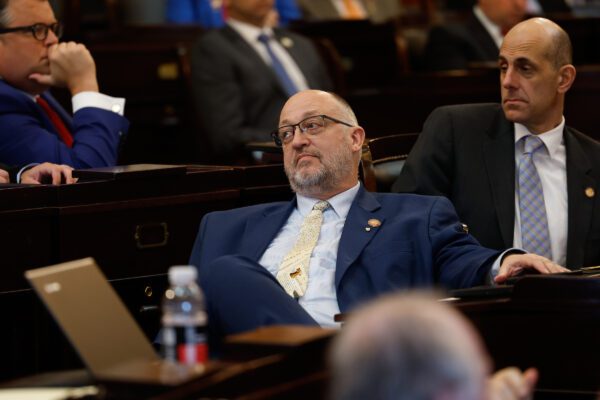
By Robbie Sequeira, Used with Permission from Ohio Capital Journal
As states rush to address falling literacy scores, a new kind of education debate in state legislatures is taking hold: not whether reading instruction needs fixing, but how to fix it.
More than a dozen states have enacted laws banning public school educators from teaching youngsters to read using an approach that’s been popular for decades. The method, known as “three-cueing,” encourages kids to figure out unfamiliar words using context clues such as meaning, sentence structure, and visual hints.
In the past two years, several states have instead embraced instruction rooted in what’s known as the “science of reading.” That approach leans heavily on phonics — relying on letter and rhyming sounds to read words such as cat, hat, and rat.
The policy discussions on early literacy are unfolding against a backdrop of alarming national reading proficiency levels. The 2024 Nation’s Report Card revealed that 40% of fourth graders and 33% of eighth graders scored below the basic reading level — the highest percentages in decades.
No state improved in fourth- or eighth-grade reading in 2024. Eight states — Alaska, Arizona, Delaware, Florida, Nebraska, Nevada, Utah, and Vermont — scored worse than they did a year or two prior in eighth-grade reading.
Five states — Arizona, Florida, Nebraska, South Dakota, and Vermont — saw dips in their fourth-grade reading scores.
In response to these troubling trends, a growing number of states are moving beyond localized efforts and tackling literacy through statewide legislation.
New Jersey last year mandated universal K-3 literacy screenings. Indiana lawmakers this month passed a bill that would allow some students to retake required reading tests before being held back in third grade; that bill is en route to the governor’s desk.
Oregon and Washington are weighing statewide literacy coaching and training models, while lawmakers in Montana introduced a bill to allow literacy interventions to cover broader reading and academic skills, not just early reading basics.
Mississippi, a state seen as a model for turnaround in literacy rates over the past decade, seeks to expand and require evidence-based reading interventions, mandatory literacy screenings and targeted teacher training, and to explicitly ban the use of three-cueing methods in reading instruction in grades 4-8.
Together, these efforts signal a national shift: States are treating literacy not as a local initiative, but as the foundation of public education policy.
“Literacy is the lever,” said Tafshier Cosby, the senior director of the Center for Organizing and Partnerships at the National Parents Union, an advocacy group. “If states focus on that, we see bipartisan wins. But the challenge is making that a statewide priority, not just a district-by-district hope.”
Before he was even sworn in, first-term Georgia Democratic state Sen. RaShaun Kemp, a former teacher and principal, had already drafted a bill to end the use of the three-cueing system in Georgia classrooms.
This month, the final version passed the state legislature without a single “no” vote. GOP Gov. Brian Kemp signed it into law Monday.
Sen. Kemp said his passion for literacy reform stretches back decades, shaped by experiences tutoring children at a local church as a college student in the early 2000s. It was there, he said, that he began noticing patterns in how students struggled with foundational reading.
“In my experience, I saw kids struggle to identify the word they were reading. I saw how some kids were guessing what the word was instead of decoding,” Kemp recalled. “And it’s not technology or screens that’s the problem. It’s what teachers are being instructed on how to teach reading. It’s the system that needs fixing, not the teachers.”
The new law requires the Professional Standards Commission — a state agency that oversees teacher prep and certification — to adopt rules mandating evidence-based reading instruction aligned with the science of reading, a set of practices rooted in decades of cognitive research on how children best learn to read.
“Current strategies used to teach literacy include methods that teach students to guess rather than read, preventing them from reaching their full potential,” Sen. Kemp said in a public statement following the bill’s legislative passage. “I know we can be better, and I’m proud to see our legislative body take much-needed steps to help make Georgia the number one state for literacy.”
In West Virginia, lawmakers have introduced similar bills that would require the state’s teachers to be certified in the science of reading.
Cosby, of the National Parents Union, said local policy changes can be driven by parents even before legislatures act.
“All politics are local,” Cosby said. “Parents don’t need to wait for statewide mandates — they can ask school boards for universal screeners and structured literacy now.”
Still, some parents worry their states are simply funding more studies on early literacy rather than taking direct action to address it.
A Portland, Oregon, parent of three — one of whom has dyslexia — sent written testimony this year urging lawmakers to skip further studies and immediately implement structured literacy statewide.
“We do not need another study to tell us what we already know — structured literacy is the most effective way to teach all children to read, particularly those with dyslexia and other reading challenges,” wrote Katherine Hoffman.
Unlike in Georgia, the “science of reading” has met resistance in other states.
In California, legislation that would require phonics-based reading instruction statewide has faced opposition from English learner advocates who argue that a one-size-fits-all approach may not effectively serve multilingual students.
In opposition to the bill, the California Teachers Association argued that by codifying a rigid definition of the “science of reading,” lawmakers ignore the evolving nature of reading research and undermine teachers’ ability to meet the diverse needs of their students.
“Placing a definition for ‘science of reading’ in statute is problematic,” wrote Seth Bramble, a legislative advocate for the California Teachers Association in a March letter addressed to the state’s Assembly Education Committee. “This bill would carve into stone scientific knowledge that by its very nature is constantly being tested, validated, refuted, revised, and improved.”
Similarly, in Wisconsin, Democratic Gov. Tony Evers in March vetoed a bill that would have reversed changes to the state’s scoring system to align the state’s benchmarks with the National Assessment of Educational Progress, a federal assessment tool that has recently been hit with funding cuts and layoffs under the Trump administration. Evers said in his veto that Republican lawmakers were stepping on the state superintendent’s independence.
That veto is another step in the evolution of a broader constitutional fight over literacy policy and how literacy funds are appropriated and released. In 2023, Wisconsin lawmakers set aside $50 million for a new statewide literacy initiative, but disagreements over legislative versus executive control have stalled its disbursement.
Indiana’s legislature faced criticism from educators over a 2024 mandate requiring 80 hours of literacy training for pre-K to sixth-grade teachers before they can renew their licenses. Teachers argued that the additional requirements were burdensome and did not account for their professional expertise.
In Illinois, literacy struggles have been building for more than a decade, according to Mailee Smith, senior director of policy at the Illinois Policy Institute. Today, only 3 in 10 Illinois third- and fourth-graders can read at grade level, based on state and national assessments.
Although Illinois lawmakers amended the school code in 2023 to create a state literacy plan, Smith noted the plan is only guidance and does not require districts to adopt evidence-based reading instruction. She urged local school boards to act on their own.
“If students can’t read by third grade, half of the fourth-grade curriculum becomes incomprehensible,” she said. “A student’s likelihood to graduate high school can be predicted by their reading skill at the end of third grade.”
Despite the challenges, Smith said even small steps can make a real difference.
“Screening, intervention, parental notice, science-based instruction, and thoughtful grade promotion — those are the five pillars, and Illinois and even local school districts can implement some of these steps right away,” she said.
“It doesn’t have to be daunting.”
Bruce Gerencser, 68, lives in rural Northwest Ohio with his wife of 47 years. He and his wife have six grown children and sixteen grandchildren. Bruce pastored Evangelical churches for twenty-five years in Ohio, Texas, and Michigan. Bruce left the ministry in 2005, and in 2008 he left Christianity. Bruce is now a humanist and an atheist.
Your comments are welcome and appreciated. All first-time comments are moderated. Please read the commenting rules before commenting.
You can email Bruce via the Contact Form.







